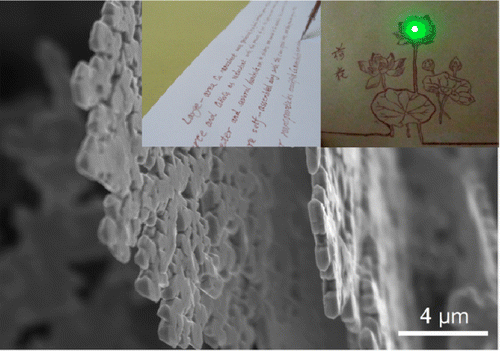Metal ink could ease the way toward flexible electronic books, displays

Scientists are reporting the development of a novel metal ink made of small sheets of copper that can be used to write a functioning, flexible electric circuit on regular printer paper. Their report on the conductive ink, which could pave the way for a wide range of new bendable gadgets, such as electronic books that look and feel more like traditional paperbacks, appears in the journal ACS Applied Materials & Interfaces.
Wenjun Dong, Ge Wang and colleagues note that the tantalizing possibilities of flexible electronics, from tablets that roll up to wearable circuits woven into clothes, have attracted a lot of attention in the past decade. But much of the progress toward this coming wave of futuristic products has entailed making circuits using complicated, time-consuming and expensive processes, which would hinder their widespread use. In response, researchers have been working toward a versatile conductive ink. They have tried several materials such as polymers and gold and silver nanostructures. So far, these materials have fallen short in one way or another. So, Dong and Wang's group decided to try copper nanosheets, which are inexpensive and highly conductive, as a flexible circuit ink.
They made copper nanosheets coated with silver nanoparticles in the laboratory and incorporated this material into an ink pen, using it to draw patterns of lines, words and even flowers on regular printer paper. Then, to show that the ink could conduct electricity, the scientists studded the drawings with small LED lights that lit up when the circuit was connected to a battery. To test the ink's flexibility, they folded the papers 1,000 times, even crumpling them up, and showed that the ink maintained 80 to 90 percent of its conductivity.
More information: "Synthesis and Self-Assembly of Large-Area Cu Nanosheets and Their Application as an Aqueous Conductive Ink on Flexible Electronics" ACS Appl. Mater. Interfaces, 2014, 6 (1), pp 622–629. DOI: 10.1021/am404708z
Abstract
Large-area Cu nanosheets are synthesized by a strategy of Cu nanocrystal self-assembly, and then aqueous conductive Cu nanosheet ink is successfully prepared for direct writing on the conductive circuits of flexible electronics. The Cu nanocrystals, as building blocks, self-assemble along the 111 direction and grow into large-area nanosheets approximately 30–100 μm in diameter and a few hundred nanometers in thickness. The laminar stackable patterns of the Cu nanosheet circuits increase the contact area of the Cu nanosheets and improve the stability of the conductor under stress, the result being that the Cu nanosheet circuits display excellent conductive performance during repeated folding and unfolding. Moreover, heterostructures of Ag nanoparticle-coated Cu nanosheets are created to improve the thermal stability of the nanosheet circuits at high temperatures.
Journal information: ACS Applied Materials and Interfaces
Provided by American Chemical Society




















